Article Analysis: Nursing Students' Peer Learning in Healthcare 2019
VerifiedAdded on 2022/10/06
|10
|3046
|19
Report
AI Summary
This report provides an analysis of a qualitative research article focusing on nursing students' perceptions of peer learning through cross-cultural student-led webinars. The study, conducted across three international universities, utilized thematic analysis of reflective journals and focus group interviews to explore the benefits and challenges of peer learning in a global context. The researchers aimed to understand how nursing students perceived peer learning during these activities. The analysis details the research methodology, including the use of convenience sampling, data collection through reflective writing and focus group discussions, and the identification of three major themes: peer learning as a creation of friendship, peer learning from interactions that went beyond what was originally intended, and peer learning as empowered learning. The report critically examines the study's strengths, such as its exploratory design and the use of qualitative data analysis techniques, while also acknowledging limitations, including the use of convenience sampling and the lack of participant verification. The study's findings highlight the development of camaraderie among students and suggests the need to internationalize these findings by carrying out further research on the topic. The report also references the COREQ checklist for qualitative research, which was used in the original study to ensure comprehensive reporting.
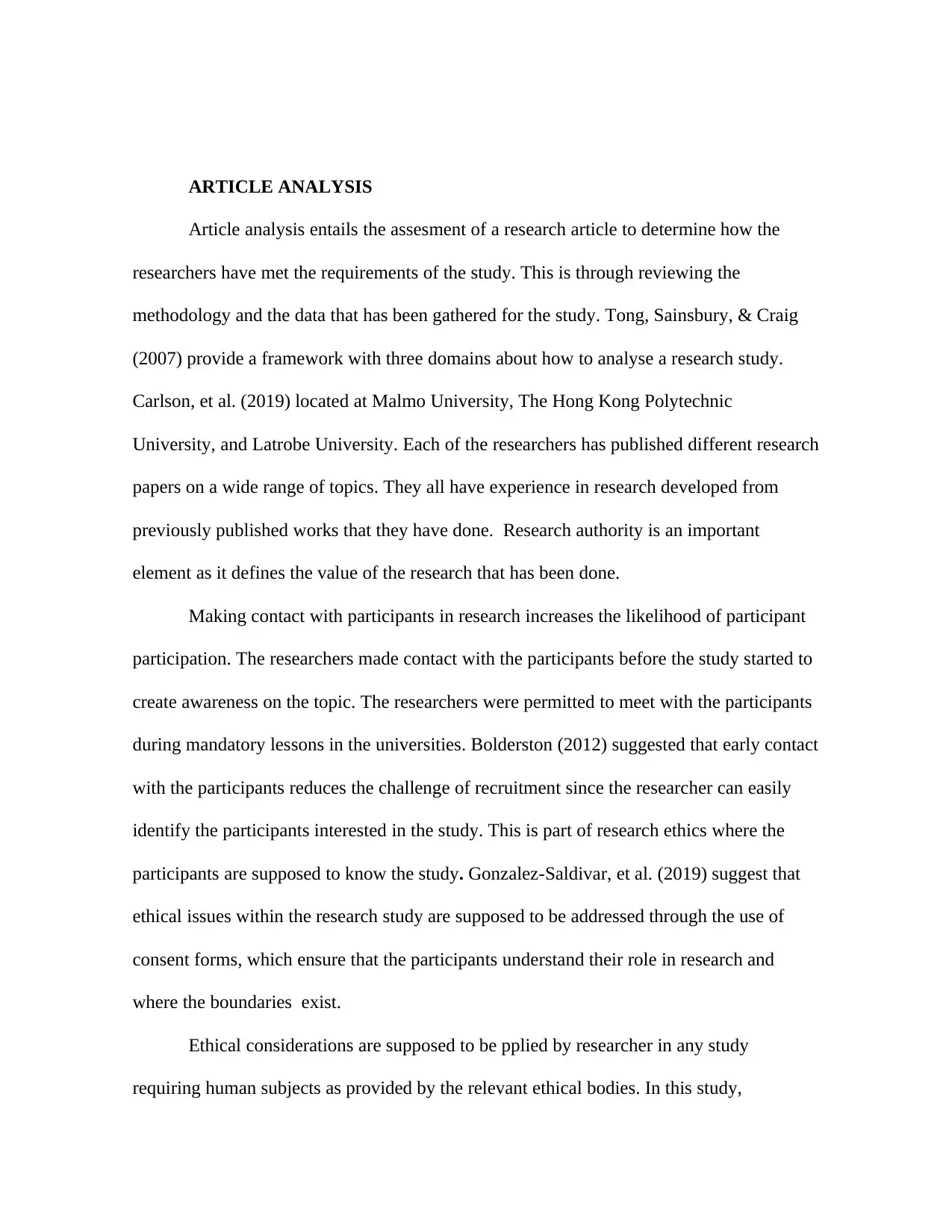
ARTICLE ANALYSIS
Article analysis entails the assesment of a research article to determine how the
researchers have met the requirements of the study. This is through reviewing the
methodology and the data that has been gathered for the study. Tong, Sainsbury, & Craig
(2007) provide a framework with three domains about how to analyse a research study.
Carlson, et al. (2019) located at Malmo University, The Hong Kong Polytechnic
University, and Latrobe University. Each of the researchers has published different research
papers on a wide range of topics. They all have experience in research developed from
previously published works that they have done. Research authority is an important
element as it defines the value of the research that has been done.
Making contact with participants in research increases the likelihood of participant
participation. The researchers made contact with the participants before the study started to
create awareness on the topic. The researchers were permitted to meet with the participants
during mandatory lessons in the universities. Bolderston (2012) suggested that early contact
with the participants reduces the challenge of recruitment since the researcher can easily
identify the participants interested in the study. This is part of research ethics where the
participants are supposed to know the study. Gonzalez-Saldivar, et al. (2019) suggest that
ethical issues within the research study are supposed to be addressed through the use of
consent forms, which ensure that the participants understand their role in research and
where the boundaries exist.
Ethical considerations are supposed to be pplied by researcher in any study
requiring human subjects as provided by the relevant ethical bodies. In this study,
Article analysis entails the assesment of a research article to determine how the
researchers have met the requirements of the study. This is through reviewing the
methodology and the data that has been gathered for the study. Tong, Sainsbury, & Craig
(2007) provide a framework with three domains about how to analyse a research study.
Carlson, et al. (2019) located at Malmo University, The Hong Kong Polytechnic
University, and Latrobe University. Each of the researchers has published different research
papers on a wide range of topics. They all have experience in research developed from
previously published works that they have done. Research authority is an important
element as it defines the value of the research that has been done.
Making contact with participants in research increases the likelihood of participant
participation. The researchers made contact with the participants before the study started to
create awareness on the topic. The researchers were permitted to meet with the participants
during mandatory lessons in the universities. Bolderston (2012) suggested that early contact
with the participants reduces the challenge of recruitment since the researcher can easily
identify the participants interested in the study. This is part of research ethics where the
participants are supposed to know the study. Gonzalez-Saldivar, et al. (2019) suggest that
ethical issues within the research study are supposed to be addressed through the use of
consent forms, which ensure that the participants understand their role in research and
where the boundaries exist.
Ethical considerations are supposed to be pplied by researcher in any study
requiring human subjects as provided by the relevant ethical bodies. In this study,
Paraphrase This Document
Need a fresh take? Get an instant paraphrase of this document with our AI Paraphraser
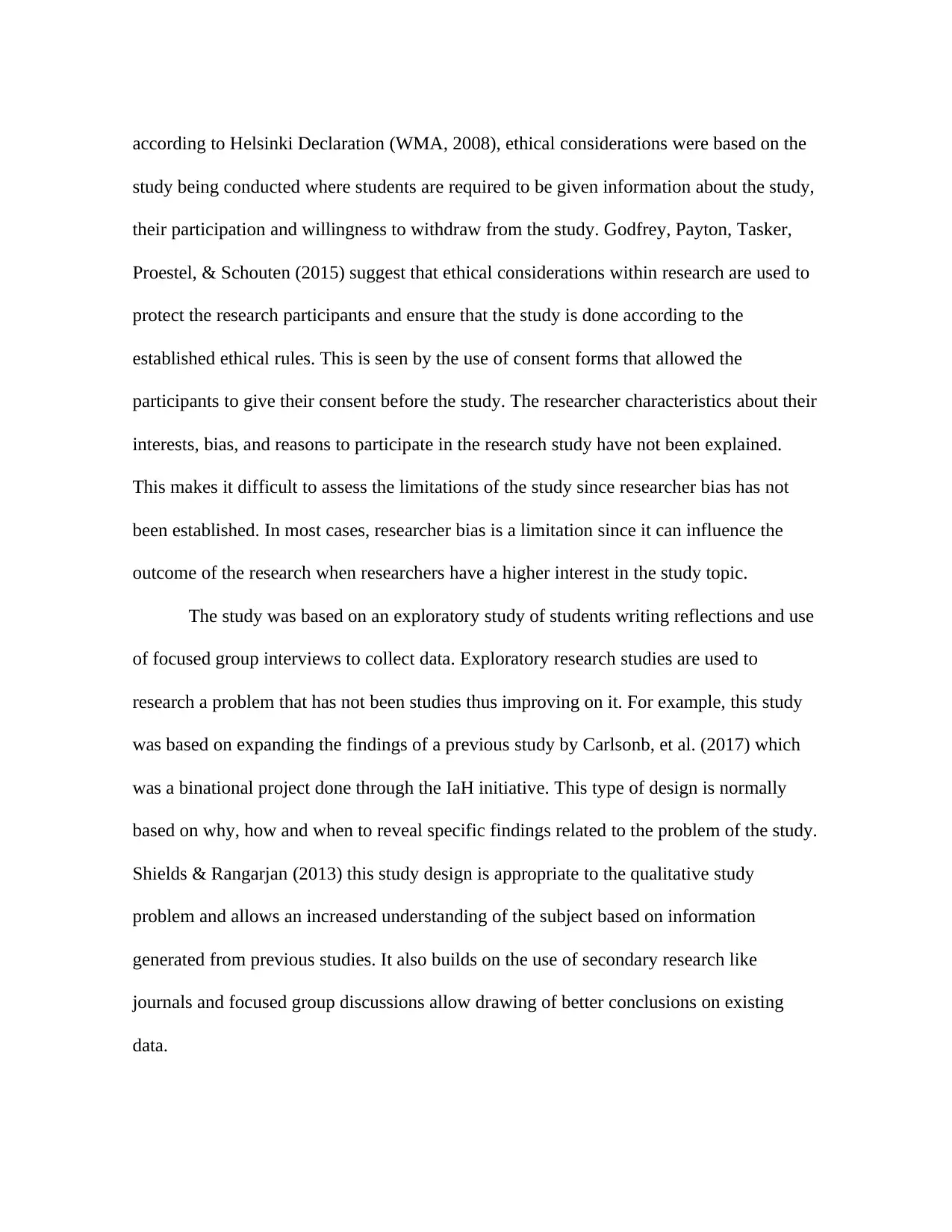
according to Helsinki Declaration (WMA, 2008), ethical considerations were based on the
study being conducted where students are required to be given information about the study,
their participation and willingness to withdraw from the study. Godfrey, Payton, Tasker,
Proestel, & Schouten (2015) suggest that ethical considerations within research are used to
protect the research participants and ensure that the study is done according to the
established ethical rules. This is seen by the use of consent forms that allowed the
participants to give their consent before the study. The researcher characteristics about their
interests, bias, and reasons to participate in the research study have not been explained.
This makes it difficult to assess the limitations of the study since researcher bias has not
been established. In most cases, researcher bias is a limitation since it can influence the
outcome of the research when researchers have a higher interest in the study topic.
The study was based on an exploratory study of students writing reflections and use
of focused group interviews to collect data. Exploratory research studies are used to
research a problem that has not been studies thus improving on it. For example, this study
was based on expanding the findings of a previous study by Carlsonb, et al. (2017) which
was a binational project done through the IaH initiative. This type of design is normally
based on why, how and when to reveal specific findings related to the problem of the study.
Shields & Rangarjan (2013) this study design is appropriate to the qualitative study
problem and allows an increased understanding of the subject based on information
generated from previous studies. It also builds on the use of secondary research like
journals and focused group discussions allow drawing of better conclusions on existing
data.
study being conducted where students are required to be given information about the study,
their participation and willingness to withdraw from the study. Godfrey, Payton, Tasker,
Proestel, & Schouten (2015) suggest that ethical considerations within research are used to
protect the research participants and ensure that the study is done according to the
established ethical rules. This is seen by the use of consent forms that allowed the
participants to give their consent before the study. The researcher characteristics about their
interests, bias, and reasons to participate in the research study have not been explained.
This makes it difficult to assess the limitations of the study since researcher bias has not
been established. In most cases, researcher bias is a limitation since it can influence the
outcome of the research when researchers have a higher interest in the study topic.
The study was based on an exploratory study of students writing reflections and use
of focused group interviews to collect data. Exploratory research studies are used to
research a problem that has not been studies thus improving on it. For example, this study
was based on expanding the findings of a previous study by Carlsonb, et al. (2017) which
was a binational project done through the IaH initiative. This type of design is normally
based on why, how and when to reveal specific findings related to the problem of the study.
Shields & Rangarjan (2013) this study design is appropriate to the qualitative study
problem and allows an increased understanding of the subject based on information
generated from previous studies. It also builds on the use of secondary research like
journals and focused group discussions allow drawing of better conclusions on existing
data.
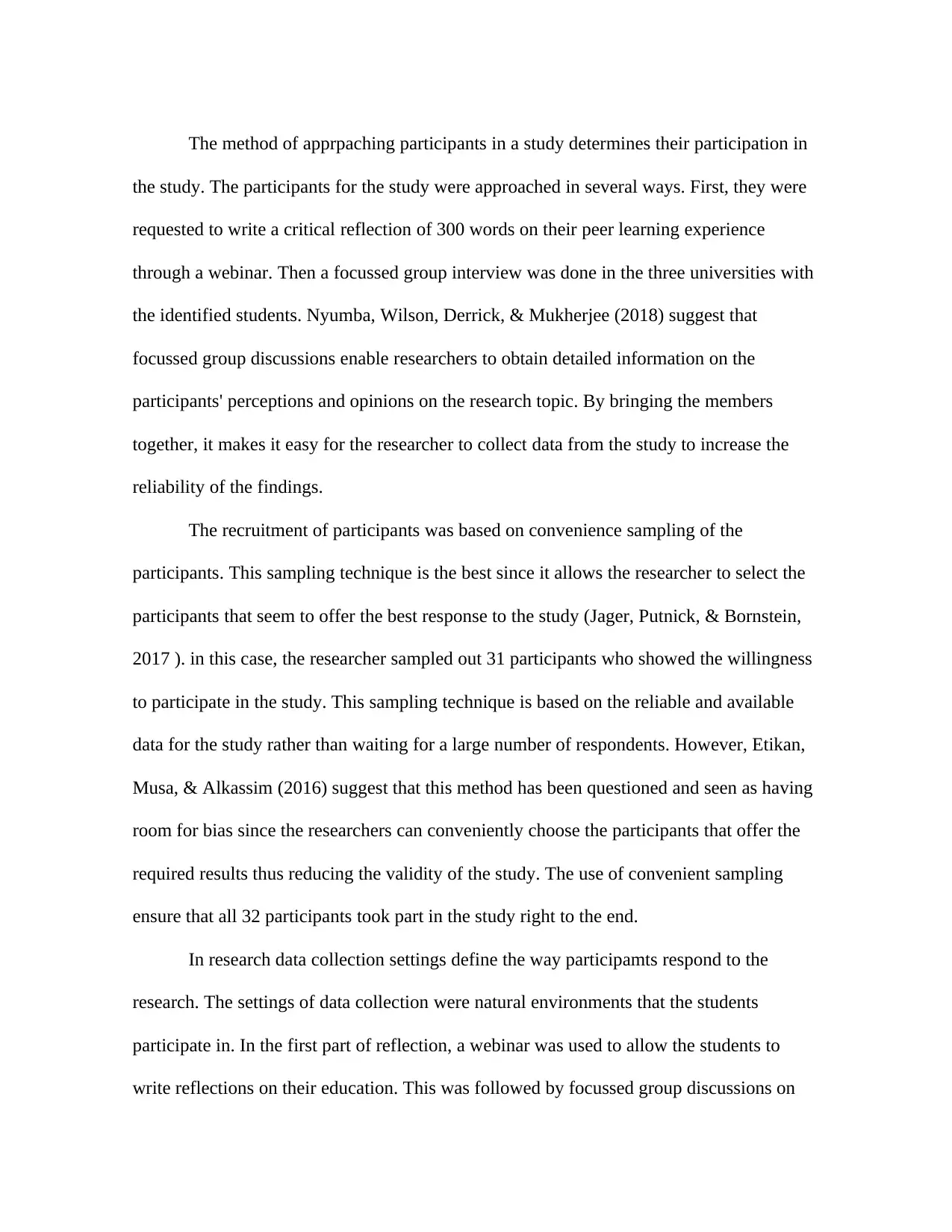
The method of apprpaching participants in a study determines their participation in
the study. The participants for the study were approached in several ways. First, they were
requested to write a critical reflection of 300 words on their peer learning experience
through a webinar. Then a focussed group interview was done in the three universities with
the identified students. Nyumba, Wilson, Derrick, & Mukherjee (2018) suggest that
focussed group discussions enable researchers to obtain detailed information on the
participants' perceptions and opinions on the research topic. By bringing the members
together, it makes it easy for the researcher to collect data from the study to increase the
reliability of the findings.
The recruitment of participants was based on convenience sampling of the
participants. This sampling technique is the best since it allows the researcher to select the
participants that seem to offer the best response to the study (Jager, Putnick, & Bornstein,
2017 ). in this case, the researcher sampled out 31 participants who showed the willingness
to participate in the study. This sampling technique is based on the reliable and available
data for the study rather than waiting for a large number of respondents. However, Etikan,
Musa, & Alkassim (2016) suggest that this method has been questioned and seen as having
room for bias since the researchers can conveniently choose the participants that offer the
required results thus reducing the validity of the study. The use of convenient sampling
ensure that all 32 participants took part in the study right to the end.
In research data collection settings define the way participamts respond to the
research. The settings of data collection were natural environments that the students
participate in. In the first part of reflection, a webinar was used to allow the students to
write reflections on their education. This was followed by focussed group discussions on
the study. The participants for the study were approached in several ways. First, they were
requested to write a critical reflection of 300 words on their peer learning experience
through a webinar. Then a focussed group interview was done in the three universities with
the identified students. Nyumba, Wilson, Derrick, & Mukherjee (2018) suggest that
focussed group discussions enable researchers to obtain detailed information on the
participants' perceptions and opinions on the research topic. By bringing the members
together, it makes it easy for the researcher to collect data from the study to increase the
reliability of the findings.
The recruitment of participants was based on convenience sampling of the
participants. This sampling technique is the best since it allows the researcher to select the
participants that seem to offer the best response to the study (Jager, Putnick, & Bornstein,
2017 ). in this case, the researcher sampled out 31 participants who showed the willingness
to participate in the study. This sampling technique is based on the reliable and available
data for the study rather than waiting for a large number of respondents. However, Etikan,
Musa, & Alkassim (2016) suggest that this method has been questioned and seen as having
room for bias since the researchers can conveniently choose the participants that offer the
required results thus reducing the validity of the study. The use of convenient sampling
ensure that all 32 participants took part in the study right to the end.
In research data collection settings define the way participamts respond to the
research. The settings of data collection were natural environments that the students
participate in. In the first part of reflection, a webinar was used to allow the students to
write reflections on their education. This was followed by focussed group discussions on
⊘ This is a preview!⊘
Do you want full access?
Subscribe today to unlock all pages.

Trusted by 1+ million students worldwide
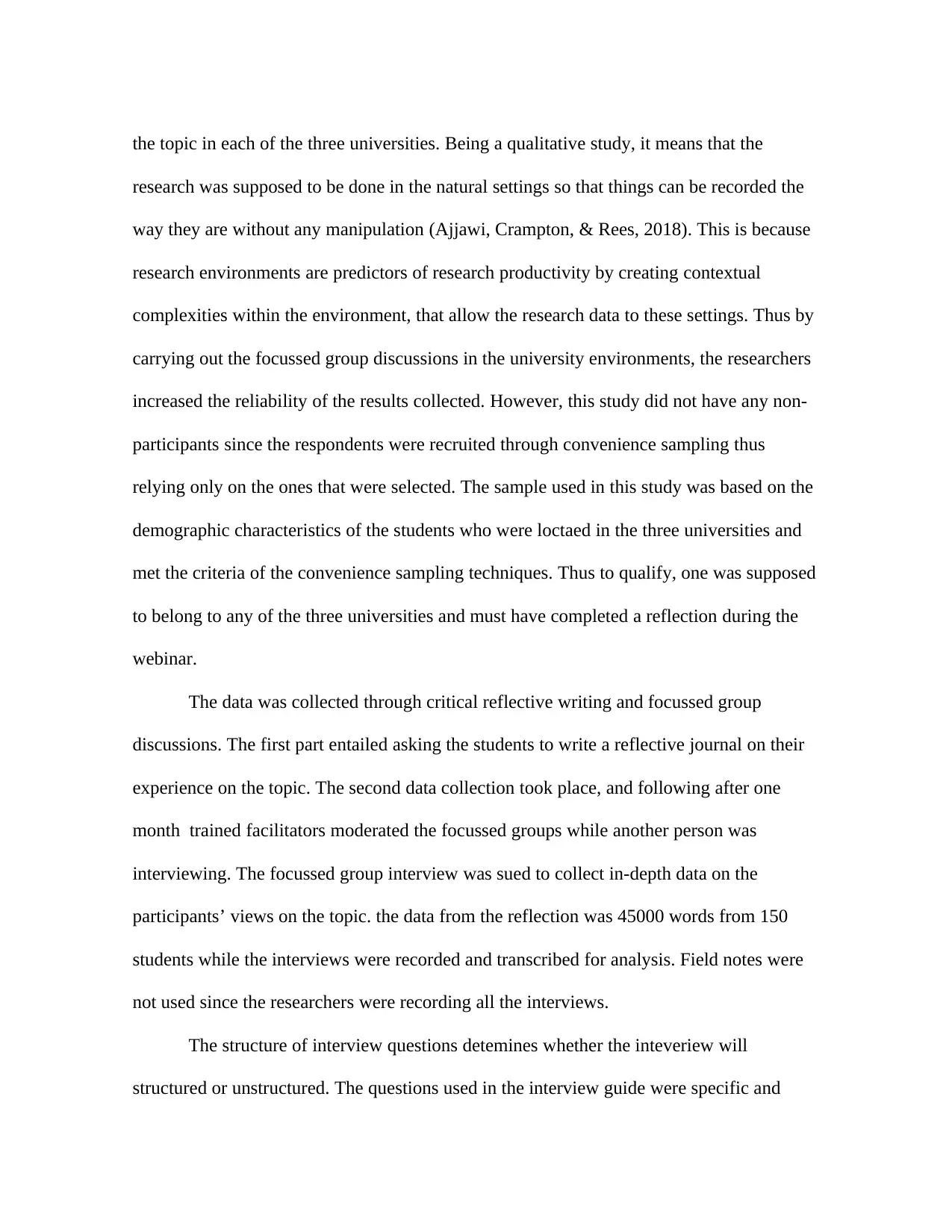
the topic in each of the three universities. Being a qualitative study, it means that the
research was supposed to be done in the natural settings so that things can be recorded the
way they are without any manipulation (Ajjawi, Crampton, & Rees, 2018). This is because
research environments are predictors of research productivity by creating contextual
complexities within the environment, that allow the research data to these settings. Thus by
carrying out the focussed group discussions in the university environments, the researchers
increased the reliability of the results collected. However, this study did not have any non-
participants since the respondents were recruited through convenience sampling thus
relying only on the ones that were selected. The sample used in this study was based on the
demographic characteristics of the students who were loctaed in the three universities and
met the criteria of the convenience sampling techniques. Thus to qualify, one was supposed
to belong to any of the three universities and must have completed a reflection during the
webinar.
The data was collected through critical reflective writing and focussed group
discussions. The first part entailed asking the students to write a reflective journal on their
experience on the topic. The second data collection took place, and following after one
month trained facilitators moderated the focussed groups while another person was
interviewing. The focussed group interview was sued to collect in-depth data on the
participants’ views on the topic. the data from the reflection was 45000 words from 150
students while the interviews were recorded and transcribed for analysis. Field notes were
not used since the researchers were recording all the interviews.
The structure of interview questions detemines whether the inteveriew will
structured or unstructured. The questions used in the interview guide were specific and
research was supposed to be done in the natural settings so that things can be recorded the
way they are without any manipulation (Ajjawi, Crampton, & Rees, 2018). This is because
research environments are predictors of research productivity by creating contextual
complexities within the environment, that allow the research data to these settings. Thus by
carrying out the focussed group discussions in the university environments, the researchers
increased the reliability of the results collected. However, this study did not have any non-
participants since the respondents were recruited through convenience sampling thus
relying only on the ones that were selected. The sample used in this study was based on the
demographic characteristics of the students who were loctaed in the three universities and
met the criteria of the convenience sampling techniques. Thus to qualify, one was supposed
to belong to any of the three universities and must have completed a reflection during the
webinar.
The data was collected through critical reflective writing and focussed group
discussions. The first part entailed asking the students to write a reflective journal on their
experience on the topic. The second data collection took place, and following after one
month trained facilitators moderated the focussed groups while another person was
interviewing. The focussed group interview was sued to collect in-depth data on the
participants’ views on the topic. the data from the reflection was 45000 words from 150
students while the interviews were recorded and transcribed for analysis. Field notes were
not used since the researchers were recording all the interviews.
The structure of interview questions detemines whether the inteveriew will
structured or unstructured. The questions used in the interview guide were specific and
Paraphrase This Document
Need a fresh take? Get an instant paraphrase of this document with our AI Paraphraser
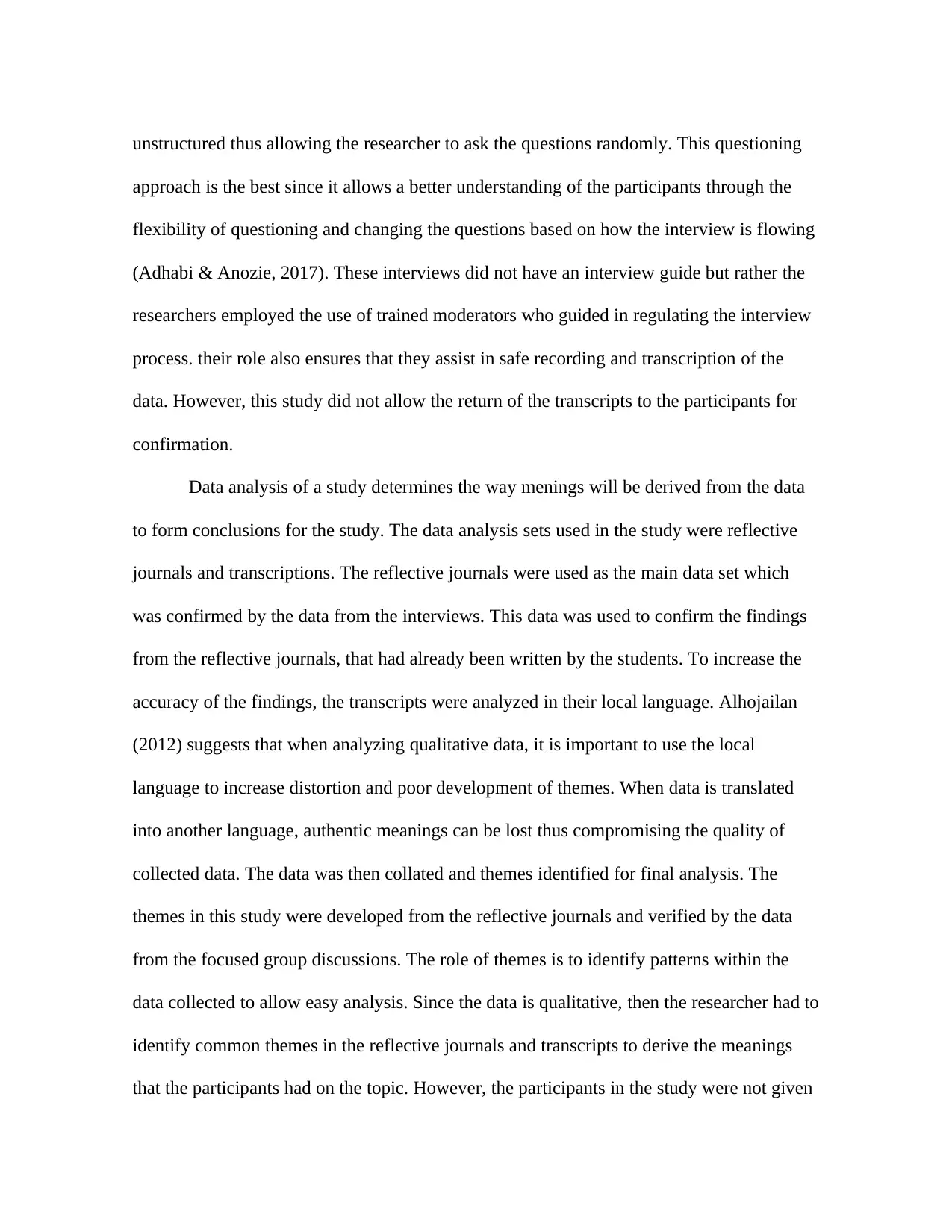
unstructured thus allowing the researcher to ask the questions randomly. This questioning
approach is the best since it allows a better understanding of the participants through the
flexibility of questioning and changing the questions based on how the interview is flowing
(Adhabi & Anozie, 2017). These interviews did not have an interview guide but rather the
researchers employed the use of trained moderators who guided in regulating the interview
process. their role also ensures that they assist in safe recording and transcription of the
data. However, this study did not allow the return of the transcripts to the participants for
confirmation.
Data analysis of a study determines the way menings will be derived from the data
to form conclusions for the study. The data analysis sets used in the study were reflective
journals and transcriptions. The reflective journals were used as the main data set which
was confirmed by the data from the interviews. This data was used to confirm the findings
from the reflective journals, that had already been written by the students. To increase the
accuracy of the findings, the transcripts were analyzed in their local language. Alhojailan
(2012) suggests that when analyzing qualitative data, it is important to use the local
language to increase distortion and poor development of themes. When data is translated
into another language, authentic meanings can be lost thus compromising the quality of
collected data. The data was then collated and themes identified for final analysis. The
themes in this study were developed from the reflective journals and verified by the data
from the focused group discussions. The role of themes is to identify patterns within the
data collected to allow easy analysis. Since the data is qualitative, then the researcher had to
identify common themes in the reflective journals and transcripts to derive the meanings
that the participants had on the topic. However, the participants in the study were not given
approach is the best since it allows a better understanding of the participants through the
flexibility of questioning and changing the questions based on how the interview is flowing
(Adhabi & Anozie, 2017). These interviews did not have an interview guide but rather the
researchers employed the use of trained moderators who guided in regulating the interview
process. their role also ensures that they assist in safe recording and transcription of the
data. However, this study did not allow the return of the transcripts to the participants for
confirmation.
Data analysis of a study determines the way menings will be derived from the data
to form conclusions for the study. The data analysis sets used in the study were reflective
journals and transcriptions. The reflective journals were used as the main data set which
was confirmed by the data from the interviews. This data was used to confirm the findings
from the reflective journals, that had already been written by the students. To increase the
accuracy of the findings, the transcripts were analyzed in their local language. Alhojailan
(2012) suggests that when analyzing qualitative data, it is important to use the local
language to increase distortion and poor development of themes. When data is translated
into another language, authentic meanings can be lost thus compromising the quality of
collected data. The data was then collated and themes identified for final analysis. The
themes in this study were developed from the reflective journals and verified by the data
from the focused group discussions. The role of themes is to identify patterns within the
data collected to allow easy analysis. Since the data is qualitative, then the researcher had to
identify common themes in the reflective journals and transcripts to derive the meanings
that the participants had on the topic. However, the participants in the study were not given
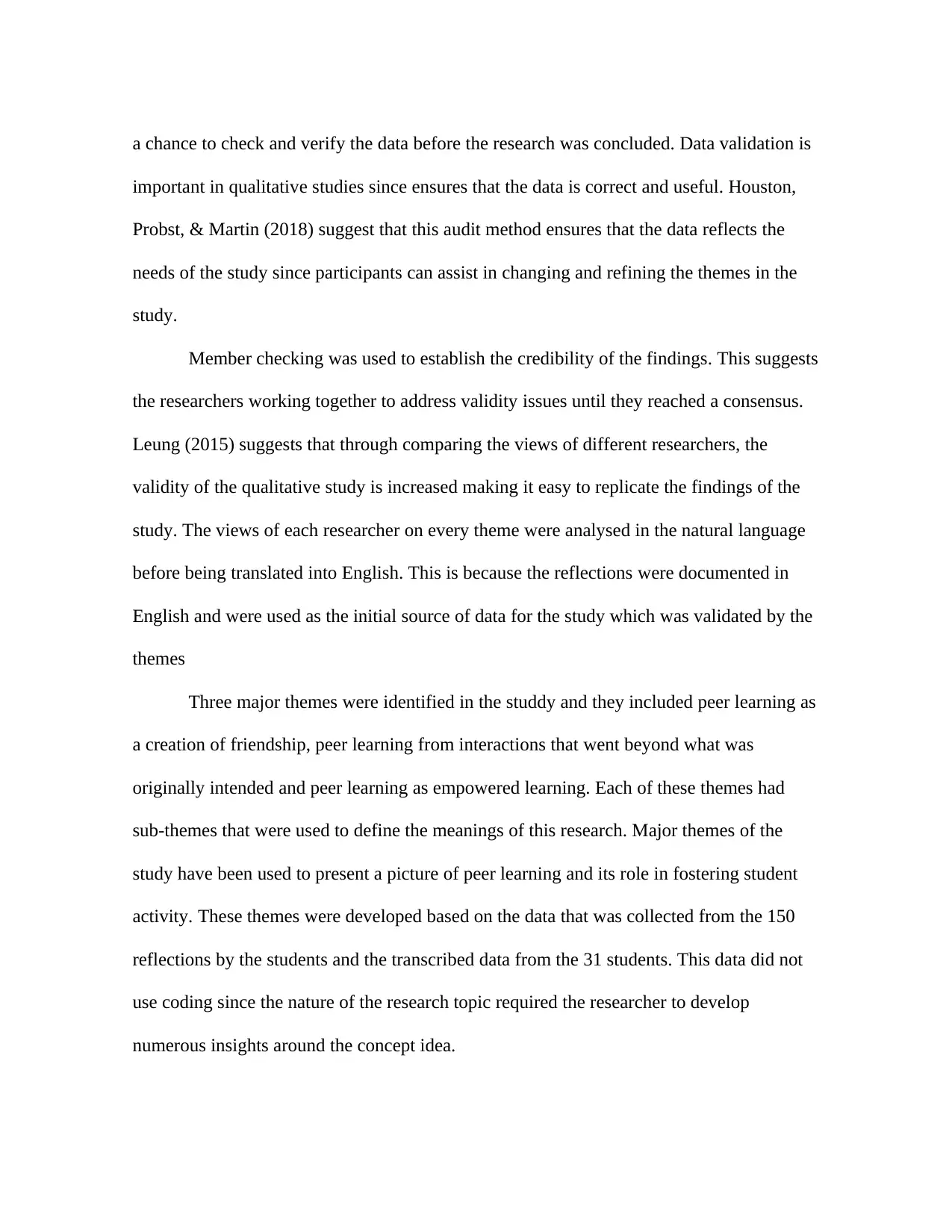
a chance to check and verify the data before the research was concluded. Data validation is
important in qualitative studies since ensures that the data is correct and useful. Houston,
Probst, & Martin (2018) suggest that this audit method ensures that the data reflects the
needs of the study since participants can assist in changing and refining the themes in the
study.
Member checking was used to establish the credibility of the findings. This suggests
the researchers working together to address validity issues until they reached a consensus.
Leung (2015) suggests that through comparing the views of different researchers, the
validity of the qualitative study is increased making it easy to replicate the findings of the
study. The views of each researcher on every theme were analysed in the natural language
before being translated into English. This is because the reflections were documented in
English and were used as the initial source of data for the study which was validated by the
themes
Three major themes were identified in the studdy and they included peer learning as
a creation of friendship, peer learning from interactions that went beyond what was
originally intended and peer learning as empowered learning. Each of these themes had
sub-themes that were used to define the meanings of this research. Major themes of the
study have been used to present a picture of peer learning and its role in fostering student
activity. These themes were developed based on the data that was collected from the 150
reflections by the students and the transcribed data from the 31 students. This data did not
use coding since the nature of the research topic required the researcher to develop
numerous insights around the concept idea.
important in qualitative studies since ensures that the data is correct and useful. Houston,
Probst, & Martin (2018) suggest that this audit method ensures that the data reflects the
needs of the study since participants can assist in changing and refining the themes in the
study.
Member checking was used to establish the credibility of the findings. This suggests
the researchers working together to address validity issues until they reached a consensus.
Leung (2015) suggests that through comparing the views of different researchers, the
validity of the qualitative study is increased making it easy to replicate the findings of the
study. The views of each researcher on every theme were analysed in the natural language
before being translated into English. This is because the reflections were documented in
English and were used as the initial source of data for the study which was validated by the
themes
Three major themes were identified in the studdy and they included peer learning as
a creation of friendship, peer learning from interactions that went beyond what was
originally intended and peer learning as empowered learning. Each of these themes had
sub-themes that were used to define the meanings of this research. Major themes of the
study have been used to present a picture of peer learning and its role in fostering student
activity. These themes were developed based on the data that was collected from the 150
reflections by the students and the transcribed data from the 31 students. This data did not
use coding since the nature of the research topic required the researcher to develop
numerous insights around the concept idea.
⊘ This is a preview!⊘
Do you want full access?
Subscribe today to unlock all pages.

Trusted by 1+ million students worldwide
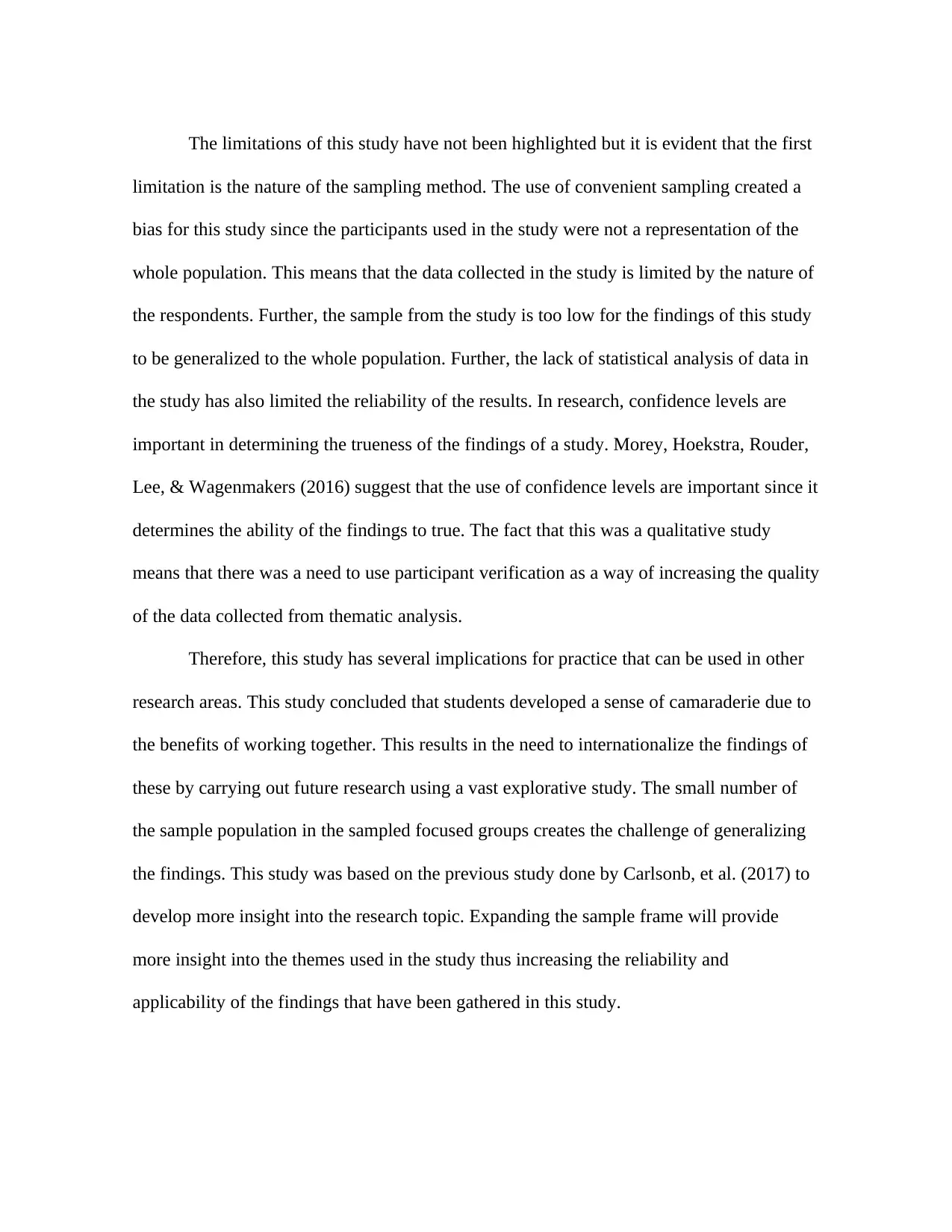
The limitations of this study have not been highlighted but it is evident that the first
limitation is the nature of the sampling method. The use of convenient sampling created a
bias for this study since the participants used in the study were not a representation of the
whole population. This means that the data collected in the study is limited by the nature of
the respondents. Further, the sample from the study is too low for the findings of this study
to be generalized to the whole population. Further, the lack of statistical analysis of data in
the study has also limited the reliability of the results. In research, confidence levels are
important in determining the trueness of the findings of a study. Morey, Hoekstra, Rouder,
Lee, & Wagenmakers (2016) suggest that the use of confidence levels are important since it
determines the ability of the findings to true. The fact that this was a qualitative study
means that there was a need to use participant verification as a way of increasing the quality
of the data collected from thematic analysis.
Therefore, this study has several implications for practice that can be used in other
research areas. This study concluded that students developed a sense of camaraderie due to
the benefits of working together. This results in the need to internationalize the findings of
these by carrying out future research using a vast explorative study. The small number of
the sample population in the sampled focused groups creates the challenge of generalizing
the findings. This study was based on the previous study done by Carlsonb, et al. (2017) to
develop more insight into the research topic. Expanding the sample frame will provide
more insight into the themes used in the study thus increasing the reliability and
applicability of the findings that have been gathered in this study.
limitation is the nature of the sampling method. The use of convenient sampling created a
bias for this study since the participants used in the study were not a representation of the
whole population. This means that the data collected in the study is limited by the nature of
the respondents. Further, the sample from the study is too low for the findings of this study
to be generalized to the whole population. Further, the lack of statistical analysis of data in
the study has also limited the reliability of the results. In research, confidence levels are
important in determining the trueness of the findings of a study. Morey, Hoekstra, Rouder,
Lee, & Wagenmakers (2016) suggest that the use of confidence levels are important since it
determines the ability of the findings to true. The fact that this was a qualitative study
means that there was a need to use participant verification as a way of increasing the quality
of the data collected from thematic analysis.
Therefore, this study has several implications for practice that can be used in other
research areas. This study concluded that students developed a sense of camaraderie due to
the benefits of working together. This results in the need to internationalize the findings of
these by carrying out future research using a vast explorative study. The small number of
the sample population in the sampled focused groups creates the challenge of generalizing
the findings. This study was based on the previous study done by Carlsonb, et al. (2017) to
develop more insight into the research topic. Expanding the sample frame will provide
more insight into the themes used in the study thus increasing the reliability and
applicability of the findings that have been gathered in this study.
Paraphrase This Document
Need a fresh take? Get an instant paraphrase of this document with our AI Paraphraser
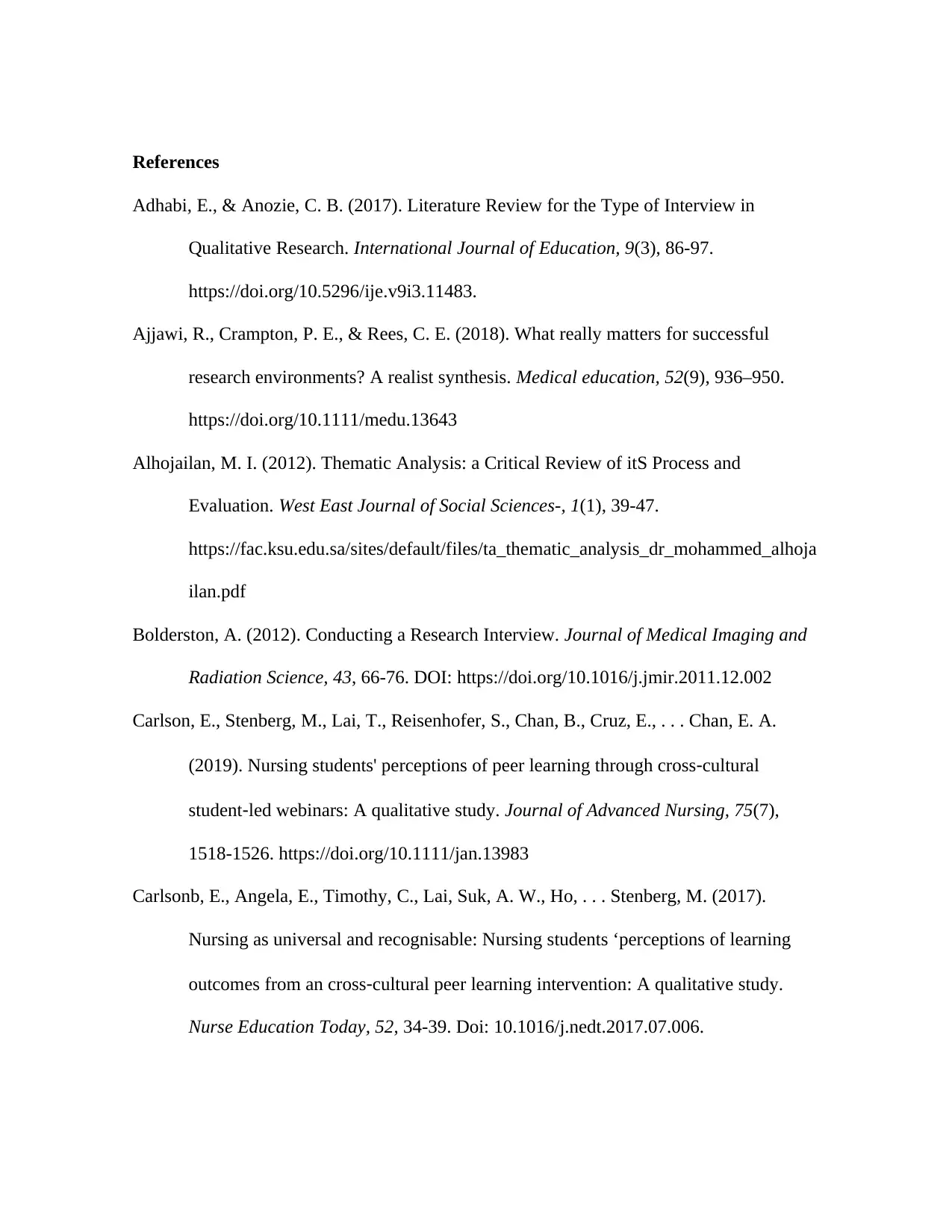
References
Adhabi, E., & Anozie, C. B. (2017). Literature Review for the Type of Interview in
Qualitative Research. International Journal of Education, 9(3), 86-97.
https://doi.org/10.5296/ije.v9i3.11483.
Ajjawi, R., Crampton, P. E., & Rees, C. E. (2018). What really matters for successful
research environments? A realist synthesis. Medical education, 52(9), 936–950.
https://doi.org/10.1111/medu.13643
Alhojailan, M. I. (2012). Thematic Analysis: a Critical Review of itS Process and
Evaluation. West East Journal of Social Sciences-, 1(1), 39-47.
https://fac.ksu.edu.sa/sites/default/files/ta_thematic_analysis_dr_mohammed_alhoja
ilan.pdf
Bolderston, A. (2012). Conducting a Research Interview. Journal of Medical Imaging and
Radiation Science, 43, 66-76. DOI: https://doi.org/10.1016/j.jmir.2011.12.002
Carlson, E., Stenberg, M., Lai, T., Reisenhofer, S., Chan, B., Cruz, E., . . . Chan, E. A.
(2019). Nursing students' perceptions of peer learning through cross‐cultural
student‐led webinars: A qualitative study. Journal of Advanced Nursing, 75(7),
1518-1526. https://doi.org/10.1111/jan.13983
Carlsonb, E., Angela, E., Timothy, C., Lai, Suk, A. W., Ho, . . . Stenberg, M. (2017).
Nursing as universal and recognisable: Nursing students ‘perceptions of learning
outcomes from an cross‐cultural peer learning intervention: A qualitative study.
Nurse Education Today, 52, 34-39. Doi: 10.1016/j.nedt.2017.07.006.
Adhabi, E., & Anozie, C. B. (2017). Literature Review for the Type of Interview in
Qualitative Research. International Journal of Education, 9(3), 86-97.
https://doi.org/10.5296/ije.v9i3.11483.
Ajjawi, R., Crampton, P. E., & Rees, C. E. (2018). What really matters for successful
research environments? A realist synthesis. Medical education, 52(9), 936–950.
https://doi.org/10.1111/medu.13643
Alhojailan, M. I. (2012). Thematic Analysis: a Critical Review of itS Process and
Evaluation. West East Journal of Social Sciences-, 1(1), 39-47.
https://fac.ksu.edu.sa/sites/default/files/ta_thematic_analysis_dr_mohammed_alhoja
ilan.pdf
Bolderston, A. (2012). Conducting a Research Interview. Journal of Medical Imaging and
Radiation Science, 43, 66-76. DOI: https://doi.org/10.1016/j.jmir.2011.12.002
Carlson, E., Stenberg, M., Lai, T., Reisenhofer, S., Chan, B., Cruz, E., . . . Chan, E. A.
(2019). Nursing students' perceptions of peer learning through cross‐cultural
student‐led webinars: A qualitative study. Journal of Advanced Nursing, 75(7),
1518-1526. https://doi.org/10.1111/jan.13983
Carlsonb, E., Angela, E., Timothy, C., Lai, Suk, A. W., Ho, . . . Stenberg, M. (2017).
Nursing as universal and recognisable: Nursing students ‘perceptions of learning
outcomes from an cross‐cultural peer learning intervention: A qualitative study.
Nurse Education Today, 52, 34-39. Doi: 10.1016/j.nedt.2017.07.006.
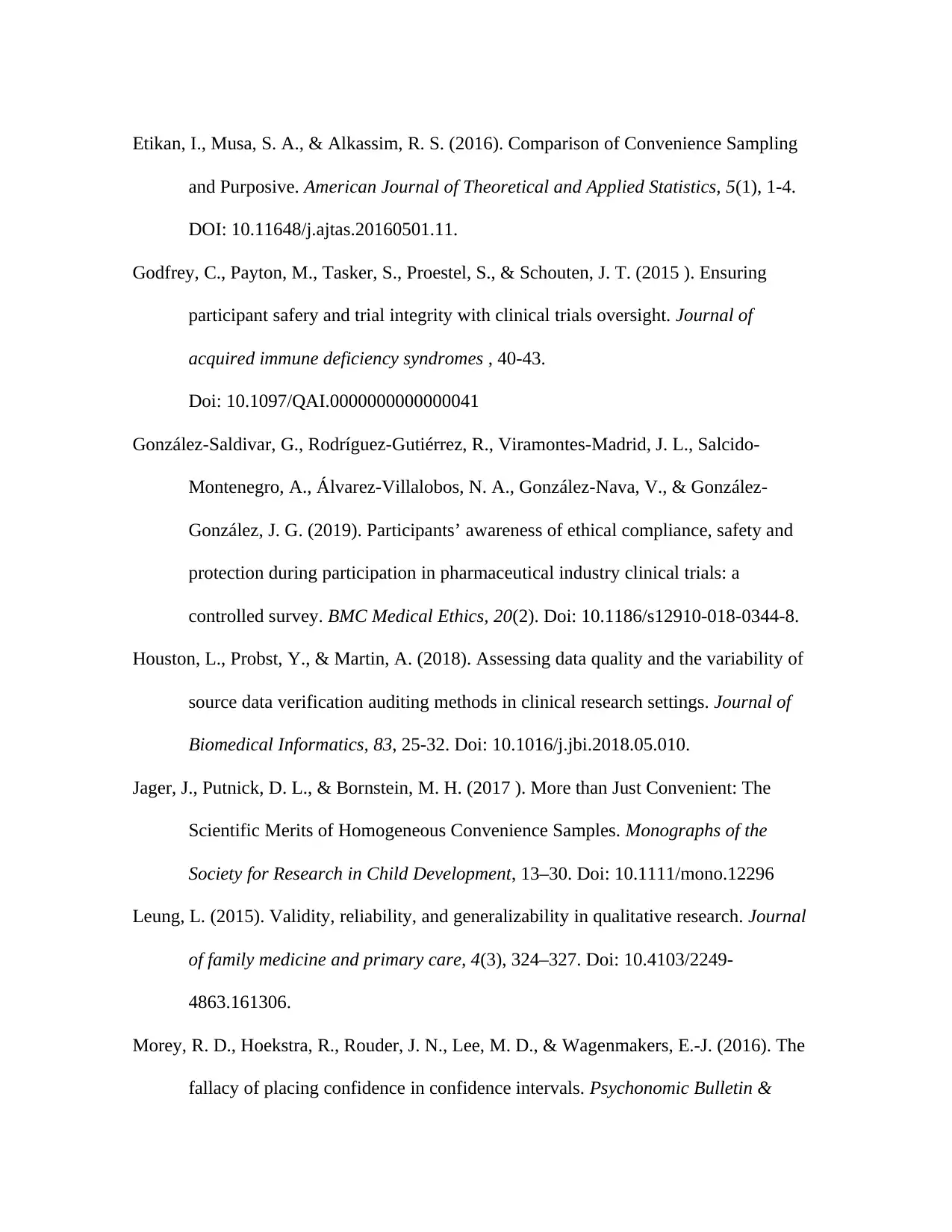
Etikan, I., Musa, S. A., & Alkassim, R. S. (2016). Comparison of Convenience Sampling
and Purposive. American Journal of Theoretical and Applied Statistics, 5(1), 1-4.
DOI: 10.11648/j.ajtas.20160501.11.
Godfrey, C., Payton, M., Tasker, S., Proestel, S., & Schouten, J. T. (2015 ). Ensuring
participant safery and trial integrity with clinical trials oversight. Journal of
acquired immune deficiency syndromes , 40-43.
Doi: 10.1097/QAI.0000000000000041
González-Saldivar, G., Rodríguez-Gutiérrez, R., Viramontes-Madrid, J. L., Salcido-
Montenegro, A., Álvarez-Villalobos, N. A., González-Nava, V., & González-
González, J. G. (2019). Participants’ awareness of ethical compliance, safety and
protection during participation in pharmaceutical industry clinical trials: a
controlled survey. BMC Medical Ethics, 20(2). Doi: 10.1186/s12910-018-0344-8.
Houston, L., Probst, Y., & Martin, A. (2018). Assessing data quality and the variability of
source data verification auditing methods in clinical research settings. Journal of
Biomedical Informatics, 83, 25-32. Doi: 10.1016/j.jbi.2018.05.010.
Jager, J., Putnick, D. L., & Bornstein, M. H. (2017 ). More than Just Convenient: The
Scientific Merits of Homogeneous Convenience Samples. Monographs of the
Society for Research in Child Development, 13–30. Doi: 10.1111/mono.12296
Leung, L. (2015). Validity, reliability, and generalizability in qualitative research. Journal
of family medicine and primary care, 4(3), 324–327. Doi: 10.4103/2249-
4863.161306.
Morey, R. D., Hoekstra, R., Rouder, J. N., Lee, M. D., & Wagenmakers, E.-J. (2016). The
fallacy of placing confidence in confidence intervals. Psychonomic Bulletin &
and Purposive. American Journal of Theoretical and Applied Statistics, 5(1), 1-4.
DOI: 10.11648/j.ajtas.20160501.11.
Godfrey, C., Payton, M., Tasker, S., Proestel, S., & Schouten, J. T. (2015 ). Ensuring
participant safery and trial integrity with clinical trials oversight. Journal of
acquired immune deficiency syndromes , 40-43.
Doi: 10.1097/QAI.0000000000000041
González-Saldivar, G., Rodríguez-Gutiérrez, R., Viramontes-Madrid, J. L., Salcido-
Montenegro, A., Álvarez-Villalobos, N. A., González-Nava, V., & González-
González, J. G. (2019). Participants’ awareness of ethical compliance, safety and
protection during participation in pharmaceutical industry clinical trials: a
controlled survey. BMC Medical Ethics, 20(2). Doi: 10.1186/s12910-018-0344-8.
Houston, L., Probst, Y., & Martin, A. (2018). Assessing data quality and the variability of
source data verification auditing methods in clinical research settings. Journal of
Biomedical Informatics, 83, 25-32. Doi: 10.1016/j.jbi.2018.05.010.
Jager, J., Putnick, D. L., & Bornstein, M. H. (2017 ). More than Just Convenient: The
Scientific Merits of Homogeneous Convenience Samples. Monographs of the
Society for Research in Child Development, 13–30. Doi: 10.1111/mono.12296
Leung, L. (2015). Validity, reliability, and generalizability in qualitative research. Journal
of family medicine and primary care, 4(3), 324–327. Doi: 10.4103/2249-
4863.161306.
Morey, R. D., Hoekstra, R., Rouder, J. N., Lee, M. D., & Wagenmakers, E.-J. (2016). The
fallacy of placing confidence in confidence intervals. Psychonomic Bulletin &
⊘ This is a preview!⊘
Do you want full access?
Subscribe today to unlock all pages.

Trusted by 1+ million students worldwide
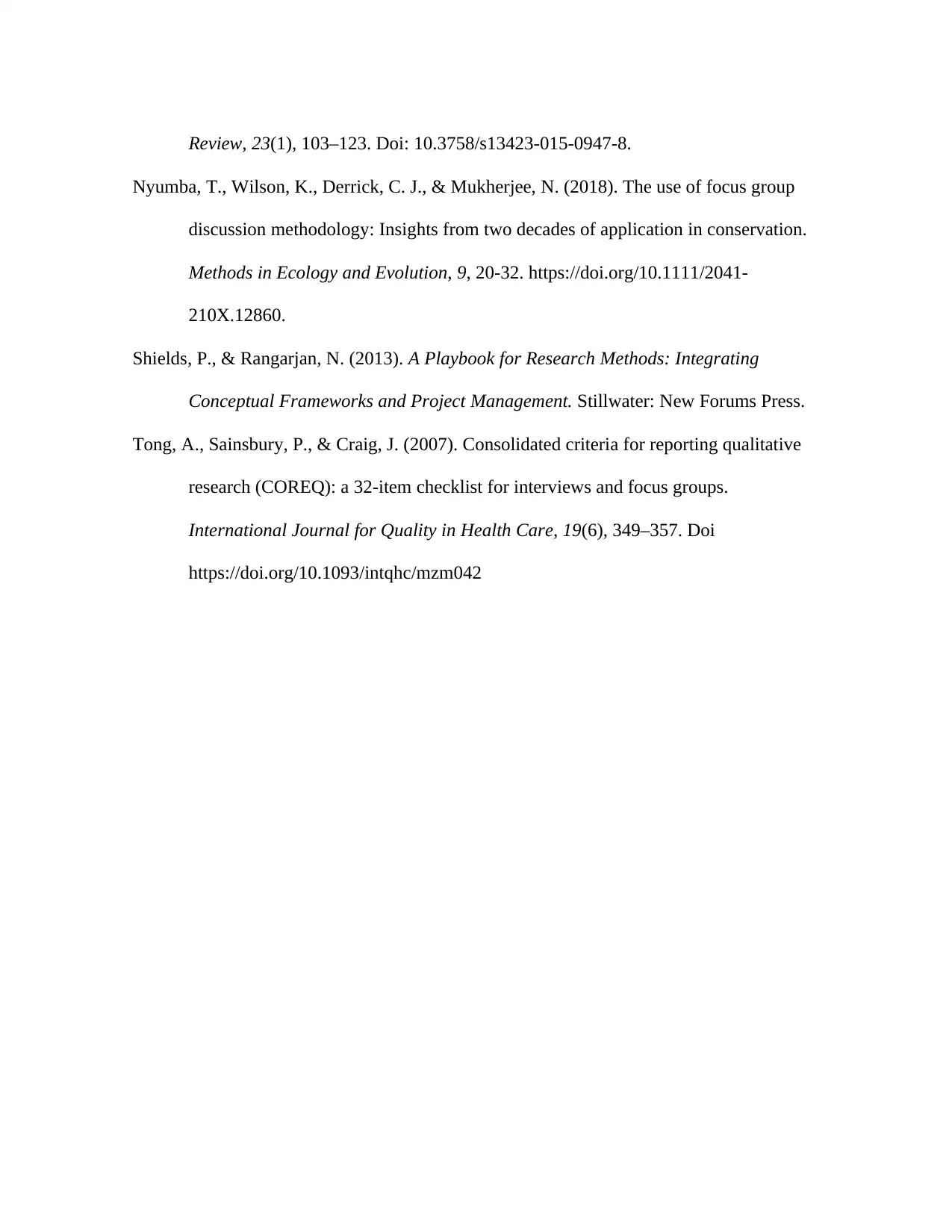
Review, 23(1), 103–123. Doi: 10.3758/s13423-015-0947-8.
Nyumba, T., Wilson, K., Derrick, C. J., & Mukherjee, N. (2018). The use of focus group
discussion methodology: Insights from two decades of application in conservation.
Methods in Ecology and Evolution, 9, 20-32. https://doi.org/10.1111/2041-
210X.12860.
Shields, P., & Rangarjan, N. (2013). A Playbook for Research Methods: Integrating
Conceptual Frameworks and Project Management. Stillwater: New Forums Press.
Tong, A., Sainsbury, P., & Craig, J. (2007). Consolidated criteria for reporting qualitative
research (COREQ): a 32-item checklist for interviews and focus groups.
International Journal for Quality in Health Care, 19(6), 349–357. Doi
https://doi.org/10.1093/intqhc/mzm042
Nyumba, T., Wilson, K., Derrick, C. J., & Mukherjee, N. (2018). The use of focus group
discussion methodology: Insights from two decades of application in conservation.
Methods in Ecology and Evolution, 9, 20-32. https://doi.org/10.1111/2041-
210X.12860.
Shields, P., & Rangarjan, N. (2013). A Playbook for Research Methods: Integrating
Conceptual Frameworks and Project Management. Stillwater: New Forums Press.
Tong, A., Sainsbury, P., & Craig, J. (2007). Consolidated criteria for reporting qualitative
research (COREQ): a 32-item checklist for interviews and focus groups.
International Journal for Quality in Health Care, 19(6), 349–357. Doi
https://doi.org/10.1093/intqhc/mzm042
1 out of 10
Related Documents
Your All-in-One AI-Powered Toolkit for Academic Success.
+13062052269
info@desklib.com
Available 24*7 on WhatsApp / Email
![[object Object]](/_next/static/media/star-bottom.7253800d.svg)
Unlock your academic potential
Copyright © 2020–2025 A2Z Services. All Rights Reserved. Developed and managed by ZUCOL.





